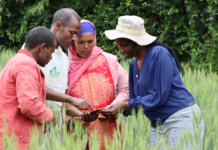In recent years, the field of genetic engineering in agriculture has been rapidly advancing, offering innovative solutions to some of the most pressing challenges in food production. As we look ahead to the period from 2023 to 2030, the global genetic engineering in agriculture market is poised to undergo significant growth, with a projected Compound Annual Growth Rate (CAGR) of 6.5%. By 2030, this market is anticipated to reach a value of approximately US$1.5 billion.
Genetic engineering in agriculture, also known as recombinant DNA (rDNA) technology, plays a pivotal role in altering the genetic makeup of crops, ultimately leading to improved crop yields, reduced production costs, decreased reliance on pesticides, and enhanced nutritional content and food quality. This article explores the key drivers, challenges, and market trends shaping the genetic engineering in agriculture sector.
Growth Drivers:
- Exploding Rise in Food Demand:
One of the primary drivers fueling the growth of genetic engineering in agriculture is the ever-increasing global demand for food. With the world’s population projected to exceed 9 billion by 2050, traditional agricultural methods face limitations in meeting this growing demand. Genetic engineering offers a solution by creating genetically modified crops that yield more produce on the same land area, thus boosting overall agricultural productivity. Additionally, these crops can be designed for improved resistance to pests and diseases, ensuring a more reliable food supply.
- Biotechnology Advancements:
Biotechnological advancements have significantly transformed genetic engineering in agriculture. Innovations in gene-editing technologies, such as CRISPR-Cas9, have allowed for precise and targeted genetic modifications in crops. These technologies are more cost-effective and have accelerated the development of genetically modified crops, making them economically viable for farmers and seed producers. These advancements have enhanced food production and resolved technical challenges in agriculture.
Market Challenges:
- Ethical and Social Concerns:
Genetic engineering in agriculture faces ethical and social concerns, particularly regarding the environmental impact of genetically modified crops on ecosystems and biodiversity. Concerns about the safety of genetically modified foods for human consumption, including allergenicity and toxicity, also persist. Socioeconomic implications, such as their impact on small-scale farmers and unequal access to genetically modified seeds, raise additional concerns.
Key Segments:
- CRISPR Remains the Most Preferred Technique:
In 2022, the CRISPR technique held the largest market share due to its precision, cost-effectiveness, and ethical advantages. CRISPR enables specific modifications to an organism’s genome without introducing foreign DNA, allaying concerns about genetic alteration. Its simplicity and versatility have revolutionized agricultural genetic engineering, enabling scientists to develop innovative crop varieties more efficiently.
- Fruits & Vegetables Leading Application Category:
The fruits and vegetables category led the market in 2022, driven by rising acceptance of genetically modified foods worldwide. Genetically modified fruits and vegetables offer increased safety through insect and herbicide resistance, along with improved flavor, texture, and scent. These modifications contribute to higher-quality produce and more resilient crops that can withstand environmental challenges.
Growth Opportunities Across Regions:
- North America’s Dominance Intact:
North America is expected to maintain its leadership in the genetic engineering in agriculture market. Factors such as advanced research facilities, rapid adoption of genetic editing techniques, and a growing demand for food contribute to its dominance. Biotechnology research in the region is anticipated to benefit from the use of genetically modified plants in recombinant vaccine production.
- Asia Pacific Develops a Lucrative Market:
The Asia Pacific region is poised to experience significant growth in genetic engineering in agriculture. Increased crop productivity, advancements in agricultural technology, and investments in research and development are key factors driving this growth. The region’s demand for crop varieties resilient to harsh weather and soil conditions further supports market expansion.
Competitive Landscape:
Some of the leading players at the forefront in the genetic engineering in agriculture market space include Eurofins Scientific, Illumina, Inc., Keygene, Agilent Technologies, Qiagen N.V., Neogen Corporation, Nrgene, Traitgenetics GmbH, Novogene Corporation, and Oxford Nanopore Technologies.








